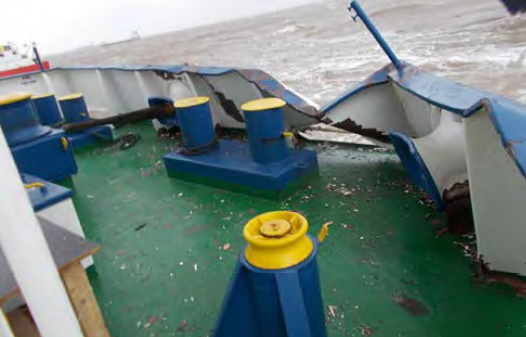In its latest Safety Digest, the UK MAIB shared an incident concerning a general cargo that because of excessive wind conditions, it collided with another vessel, which collided with another vessel, causing all vessels to sustain damages. Yet, no injuries were reported.
The Incident
Strong winds and tidal streams were forecast when the master of a small general cargo vessel was forced to change his plans and anchor overnight in an estuary to await a bunker barge. The vessel had not been able to take bunkers when alongside, and had insufficient fuel to reach its next port.
After sailing with a river pilot on board, the vessel proceeded to an anchorage as advised by the VTS. It was then anchored 40 minutes before low water in a depth of 12m using 5 shackles of cable. Several other vessels were also at anchor close-by. Shortly afterwards, the master handed over the bridge watch to the second officer, the pilot disembarked, and the main engine was stopped.
While on watch, the second officer remained on the bridge correcting charts. He was alone, and checked the vessel’s position every 30 minutes. During one of the checks, the second officer noticed that the vessel had moved significantly closer to one of the other anchored vessels.
As predicted, the easterly wind was now force 9 and the rate of the north-westerly flooding tidal stream had increased to over 2.5kts. The cargo vessel had been dragging its anchor for about 10 minutes at a speed of up to 1.4kts, and the second officer immediately alerted the master and called the engineer to start the main engine.
By the time the cargo vessel’s engineer had dressed and started the main engine it was too late to avoid a collision. The cargo vessel struck the other vessel at anchor, which then also started to drag. Both vessels then collided with a third vessel, which was also at anchor. Nobody was injured but all the vessels sustained damage.

Lessons Learned
- The ability of an anchor to bite and continue to hold relies heavily on sufficient length of chain cable being used, particularly when strong winds and tidal streams are experienced and the tidal range is large. In such conditions, the more anchor cable used the more likely a master’s rest will remain undisturbed.
- During anchor watches, bridge watchkeepers frequently use the time to catch up with a variety of tasks. Usually this is time well spent. However, position monitoring remains a key task, the frequency of which depends on local conditions and circumstances. The longer the interval between checks, the further a ship might have dragged towards danger.
- Automatic anchor watch alarm functions that are available on GPS receivers appear to be seldom used on merchant ships, even those not equipped with ECDIS or ECS. Yet such facilities, which are relatively quick and straightforward to set up, can provide real-time warning and a greater peace of mind.
- The options available when a ship drags its anchor are extremely limited if its propulsion is not available. Occasionally, when conditions dictate, this means having engines at immediate readiness.





























































